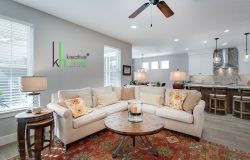“Open Concept or Traditional Layouts: Which Layout is Right for You?”
When it comes to designing or renovating your home, one of the most critical decisions you’ll face is choosing between an open concept and a traditional layout. Both styles have their unique advantages and disadvantages, and your choice will significantly impact the functionality, aesthetics, and overall feel of your living space. In this blog post, we’ll explore the pros and cons of open concept and traditional layouts to help you make a right choice.
- Open Concept Layouts
Open concept layouts have gained immense popularity in recent years, especially in contemporary home designs. They are characterized by a seamless flow between different areas of a space, typically merging the kitchen, dining, and living areas into one large, multifunctional space.

Pros of Open Concept Layouts:
Enhanced Social Interaction: One of the most significant advantages of open concept layouts is that they promote social interaction. It allows family members to engage more freely, making it an excellent choice for households where communal bonding is essential.
Natural Light and Airflow: Open layouts often have fewer walls, which means that natural light can penetrate deeper into the space. This creates a brighter and more cheerful atmosphere, reducing the need for artificial lighting during the day. Additionally, better airflow can be achieved, leading to improved indoor air quality.
Flexible Use of Space: With an open concept, you have the freedom to use the space in various ways. You can easily adapt it to your changing needs, whether you want to entertain guests, host a family dinner, or set up a home office.
Aesthetic Appeal: Open layouts tend to look more spacious and modern. They provide an opportunity to showcase interior design elements, such as statement furniture, artwork, and decorative features, which can have a significant visual impact.
Cons of Open Concept Layouts:
Lack of Privacy: The most significant drawback of open concept layouts is the lack of privacy. It can be challenging to find a quiet space for focused work or personal time when everything is interconnected.
Noise and Distractions: The open design can amplify noise levels, making it challenging to concentrate or have private conversations, especially if there are children or multiple occupants in the space.
Limited Wall Space: If you enjoy displaying art, photographs, or shelving units, an open concept layout may limit your wall space, making it more challenging to showcase your personal style.
Clutter Visibility: Since everything is in plain sight, maintaining a tidy home can be more challenging. Clutter and mess in one area may affect the overall aesthetic of the entire space.
- Traditional Layouts
Traditional layouts are characterized by distinct, separated rooms with walls and doors, each serving a specific function. This design has been a staple in architecture for centuries and is still favored by many for its classic and timeless appeal.

Pros of Traditional Layouts:
Defined Spaces: Traditional layouts provide clearly defined spaces for different purposes, offering privacy and minimizing distractions. This can be advantageous in homes with multiple generations or where different activities need separate areas.
Noise Control: Walls and doors in traditional layouts act as natural sound barriers, reducing noise transfer between rooms. This is especially beneficial if you need a quiet, focused environment.
Storage Options: The presence of walls allows for more extensive use of storage solutions, such as built-in cabinets, closets, and shelving units.
Personalization: Each room in a traditional layout can be customized to match specific tastes and functions, creating a unique and tailored living or working environment.
Cons of Traditional Layouts:
Less Natural Light: Traditional layouts can lead to darker, closed-off spaces, as they may have fewer windows and less natural light penetration. This can make rooms feel smaller and less inviting.
Reduced Social Interaction: The separation of spaces in traditional layouts may limit spontaneous interactions among occupants, potentially creating a less communal atmosphere.
Space Constraints: Traditional layouts can feel cramped, especially in smaller homes or offices, and may not accommodate large gatherings or parties as well as open concepts.
Conclusion
In the debate between open concept and traditional layouts, there’s no one-size-fits-all answer. Your choice should be driven by your lifestyle, preferences, and specific needs. Consider factors such as the number of occupants, the importance of privacy, your style preferences, and the amount of natural light you desire.
Ultimately, the perfect layout is the one that aligns with your vision of a functional and aesthetically pleasing space. Whether you opt for the openness of an open concept or the defined spaces of a traditional layout, with careful planning and design, you can create a space that truly feels like home or an efficient workspace that boosts productivity.



